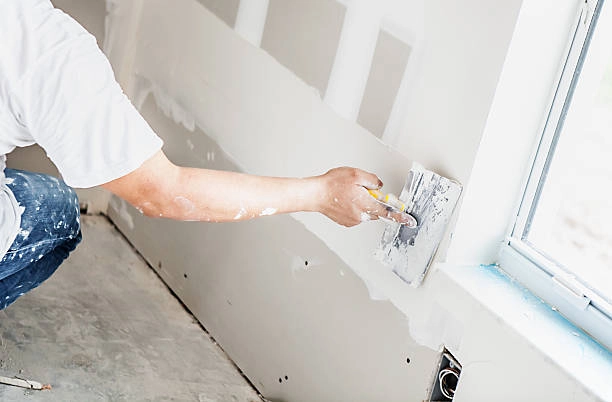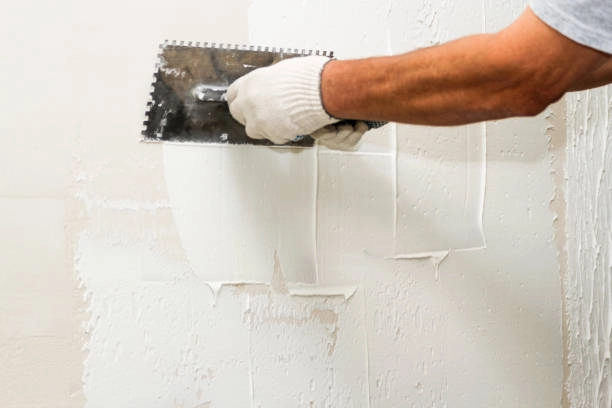Drywall, also referred to as plasterboard or gypsum board, stands as a cornerstone in contemporary interior construction. Its widespread use in both residential and commercial settings is owed to its versatility and straightforward installation process. Ideal for walls and ceilings, drywall offers a smooth, uniform surface that complements various design aesthetics. However, despite its durability, drywall is not immune to wear and tear, necessitating occasional drywall repair to maintain its integrity and appearance.
Over time, it can sustain damage from accidental impacts, water infiltration, or structural settling. Knowing how to effectively evaluate and remedy these issues, particularly through expert repair, is essential for preserving the structural integrity and visual appeal of your living or working environment.

Types of Drywall Damage
Before diving into repair methods, it’s important to identify the types of damages that commonly affect drywall:
- Cracks: These can occur due to settling, temperature fluctuations, or impact.
- Holes: Often caused by accidental impacts or the removal of fixtures.
- Water Damage: Manifests as stains, swelling, or softening of the drywall due to leaks or flooding.
- Nail Pops: When nails or screws push through the drywall, creating a bump or small hole.
- Mold or Mildew: Resulting from prolonged exposure to moisture, typically in humid areas like bathrooms or basements.
Assessing the Damage
- Visual Inspection: Begin by examining the affected area for visible signs such as cracks, holes, stains, or soft spots, which are critical in drywall repair. Pay attention to corners and joints, as these areas are more prone to damage.
- Probe the Area: Gently press on the damaged areas to assess their integrity. Soft spots or areas that give way easily indicate underlying damage that needs attention.
- Check for Moisture: If you suspect water damage, use a moisture meter or visually inspect for signs like discoloration, peeling paint, or a musty odor.
DIY vs. Professional Repair
While minor cosmetic repairs like small holes or nail pops can be tackled by confident DIYers, more extensive damage or water-related issues should be handled by professionals specializing in drywall repair. Here’s why:
- Skill and Expertise: Professional drywall contractors have the training and tools to assess the extent of the damage accurately and ensure proper repair.
- Time and Efficiency: Professionals can complete repairs efficiently, minimizing disruption to your daily life and ensuring a thorough job.
- Quality Results: A professional finish not only looks better but also lasts longer, ensuring your investment in repairs pays off over time.

Steps to Repair Drywall Damage
Small Holes and Nail Pops
- Preparation: Clean the area around the damage, removing any loose debris or old joint compound.
- Patch Application: Use a lightweight joint compound to fill the hole or depression, smoothing it with a putty knife. Allow it to dry completely.
- Sanding and Finishing: Once dry, lightly sand the patched area until smooth, a crucial step in drywall repair. Apply a second coat if necessary, feathering the edges to blend with the surrounding wall.
- Priming and Painting: Prime the repaired area to ensure a uniform finish, then paint to match the rest of the wall.
Cracks and Larger Holes
- Stabilization: For cracks, widen slightly with a utility knife to remove loose debris. Fill with joint compound or a patching material designed for larger repairs.
- Patch Application: Apply the compound in layers, allowing each to dry before applying the next. Feather the edges to blend with the wall surface.
- Reinforcement: For large holes in drywall repair, use a self-adhesive mesh patch or plywood backing to provide structural support before applying joint compound.
- Finishing: Sand smooth when dry and finish with primer and paint.
Water Damage
- Assessment: Identify and repair the source of water intrusion before repairing the drywall.
- Cut Out Damaged Sections: Remove affected drywall to expose the studs or framing behind it. Ensure the area is dry and free of mold.
- Replace and Repair: Install new drywall, tape, mud, and finish as per standard drywall installation practices.
- Preventative Measures: Consider using moisture-resistant drywall or applying a waterproofing membrane in areas prone to water damage.

In conclusion, Assessing drywall damages requires attention to detail and an understanding of the underlying causes. While minor repairs can be managed by homeowners, larger or more complex issues benefit from professional expertise. Hollywood Refinishing offers comprehensive drywall repair services, ensuring your walls and ceilings are restored to pristine condition. Whether you’re dealing with cracks, holes, or water damage, trust our skilled team to deliver quality craftsmanship and a seamless finish. Contact us today to discuss your repair needs and transform your space with confidence.
By understanding the types of drywall damage and knowing when to seek professional help, you can maintain the beauty and structural integrity of your home or business effectively. For more tips and expert advice on drywall repair, visit Hollywood Refinishing online or contact us today. Let us help you create a space that’s both functional and aesthetically pleasing, backed by decades of remodeling experience and a commitment to excellence.
Frequently Asked Questions
1. What causes drywall cracks?
Drywall cracks can result from settling, temperature changes, or impacts over time. Proper installation and maintenance help minimize these issues.
2. Can I repair small holes in drywall myself?
Yes, small holes from nails or screws can be patched with joint compound by following simple DIY instructions for drywall repair.
3. How do I know if my drywall damage requires professional repair?
If you have extensive damage, water issues, or structural concerns, it’s best to consult with a professional repair specialist for expert assessment and repair.
4. What should I do if I find mold on my drywall?
Mold indicates moisture issues. Address the source of moisture first, then consult with a professional for safe and effective mold remediation and repair.
5. How long does it take to repair drywall damage?
Repair times vary based on the extent of damage. Minor repairs may take a day or two, while extensive damage could require several days for proper assessment, drying, and repair.
6. Can water-damaged drywall be salvaged?
Depending on the severity of the water damage, sections of drywall may need to be replaced. Prompt action to dry affected areas can help salvage undamaged portions.
7. What are the benefits of hiring a professional for drywall repair?
Professionals ensure quality repairs, use proper tools and materials, and address underlying issues to prevent future problems. Their expertise ensures long-lasting results and peace of mind.




